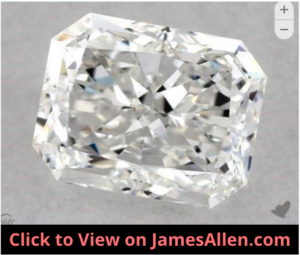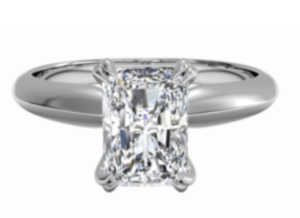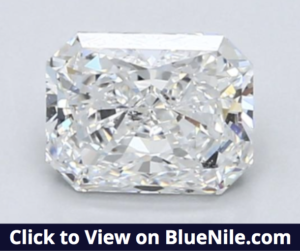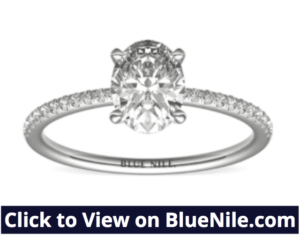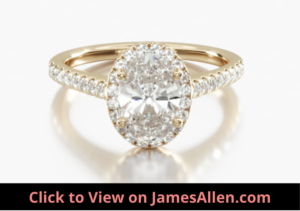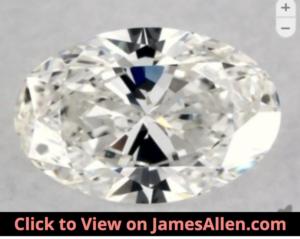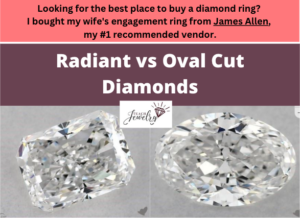
Radiant and oval cut diamonds are often used as the main gem in an engagement ring.
The main difference between radiant and oval cuts is that radiants have a squarish or rectangular shape and cropped corners. Oval cuts are an elongated shape with rounded edges. Both are brilliant cut diamonds, so the exhibit strong brilliance and hide inclusions and color.
Let’s compare radiant versus oval diamonds across each of the traits most important in determining a diamond’s quality, including brilliance, clarity, price, and more, so you’ll know which is the right choice for you.
What is a Radiant Cut Diamond?
Radiant cut diamonds are distinguished by their square or rectangular shape with cropped corners.
These brilliant cuts can have a length-to-width ratio of 1.00-1.50. For square-shaped radiant cuts, the ideal ratio is 1.00-1.03. For rectangles, it’s 1.20-1.30.
Here’s an example that’s an obvious rectangle.
Now compare it to this radiant cut, from the vendor where I bought my wife’s engagement ring, with a squarish appearance that’s vastly different from the one above.
In general, a radiant cut’s shape is comparable to a princess or cushion cut.
It’s similar to a cushion cut because they both have squarish shapes. The difference is a cushion cut’s edges are slightly curved, while radiant cuts have straight edges.
The shape mimics a princess cut, but its corners are different. Princess cuts have sharp corners, while the corners on a radiant cut are cropped to remove those points.
When placed in a setting where the corners are covered, they may look identical.
What is an Oval Cut Diamond?
Oval cut diamonds are known for their elongated shape. It’s a modern, sleek cut that combines pear and round shape cutting styles.
Check out this example an oval cut.
They come in a range of length-to-width ratios, but 1.30-1.45 is considered optimal.
It strikes the balance of highlighting its unique shape while also not resulting in a shallow diamond.
An advantage of an oval cut is it often looks larger compared to other cuts of a similar carat.
This is caused by its wide surface area, which can also make your fingers appear longer and thinner.
Modern oval cuts were invented in the mid-1900s by Lazare Kaplan, a Russian diamond cutter.
He was an expert at taking damaged pieces of gemstones and cutting away the flawed areas.
From there, he’d create new, smaller diamonds. This inspired the creation of the oval cut.
How are Radiant and Oval Cuts Different?
1. Facets
Radiant diamonds have 70 facets. Oval diamonds have 58 facets.
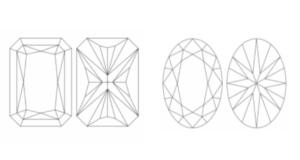
Radiant cuts were the first square cut diamond to have the brilliant facet pattern on both its crown and pavilion. This feature led to the first of its kind to be cut in a way that maximized its brilliance, a trait previously reserved for round cuts.
The high number of facets sometimes creates a “crushed ice” look. The term is often referring to cushion cuts, but the small facets in the center of radiant cuts have a similar appearance.
The facets and proportions on an oval cut diamond are most comparable to round cuts. It’s designed to capture and reflect the most light possible, so you can expect strong brilliance from oval cuts.
One difference is the facets in a given section on an oval cut are not always symmetrical. If you look closely, the individual facets will vary in shape and size.
The largest one is the table on its crown, which is surrounded by star, bezel, and upper girdle facets. On the pavilion, there’s often eight main pavilion facets with 16 on the lower girdle.
2. Clarity
The clarity of diamond is measured by the presence of imperfections known as inclusions. They take many forms, such as:
- Crystals
- Twinning wisps
- Feathers
- Cavities
The GIA scale ranges from flawless to I3, with every step down indicating the inclusions are more impactful.

A high clarity grade means there are few visible inclusions, and certain cuts are better at hiding inclusions than others.
One pro of radiant and oval cut diamonds is they both hide inclusions because of their brilliant cuts. Strong degrees of brilliance hide dark spots in a diamond because the white light conceals them.
The goal of most buyers is to find a diamond that’s eye clean. That means inclusions are only visible with magnification.
For example, the diamond below earned an SI2 clarity grade, and the inclusions aren’t visible in the high-resolution images.
But oval and radiant cuts with clarity grades of SI1 above are often eye-clean.
If you’re purchasing one that’s larger than two carats, it may require a VS2 clarity grade to hide inclusions.
For my wife’s engagement ring diamond, which weighed close to one carat, I landed on VS1 clarity.
3. Color
Color grades are determined by the extent of yellow or brown tints visible in a diamond. On the high end of the GIA color scale (D-F) are colorless diamonds.
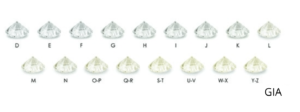
Like clarity, some cuts hide color better than others.
Round cuts are the most effective at hiding color, but the brilliance of radiant and oval cuts means light shades of yellow won’t be visible to the naked eye.
The diamond will appear colorless.
That means even color grades in the “near colorless” category such as I and H may not show color.
For example, the radiant and oval cuts below both earned G color grades.
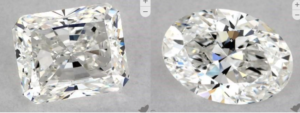
Even in those high-resolution images, they appear colorless.
You can avoid the high prices of diamonds with colorless grades while still having a radiant or oval cut that looks colorless.
4. Price
One downside of oval cuts is you can expect to pay between 15-25 percent more for an oval cut versus a radiant cut diamond if all their other qualities are equal.
Even though there are price differences within fancy shapes, they’re all less expensive than round cuts for two reasons.
The first is there’s more demand for round cuts, so the price is higher.
The second reason is round cuts waste more of the rough diamond than fancy shapes, so the manufacturer charges more to make up for the loss.
Radiant cuts are one of the least expensive cuts per carat because it uses a high percentage of the original diamond.
For a one-carat radiant cut with an H color grade and S1 clarity, you can expect to pay between $3,000-$4,000.
As an example, James Allen, an exceptional online jewelry retailer, sells these diamonds for an average of $3,480. The price range is $3,260-$3,840.
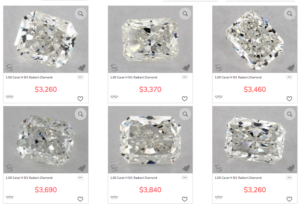
Blue Nile, another popular diamond retailer, sells them for an average of $3,534. The range is $3,142-$4,355.
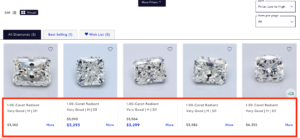
Oval cuts are priced at a premium compared to radiant cuts. The average price for an oval cut with those same qualities at James Allen is $3,991. At Blue Nile, the price is $4,387.
Although you’ll save money either way compared to a round cut, radiant cuts generally have a lower cost per carat than oval diamonds.
You can put that savings towards improved color or clarity grades, a higher carat weight, or a premium setting.
5. Size
The size of a diamond is measured in carats.
Carat is a unit of weight. One carat equals 200 milligrams. A one-carat radiant cut and a one-carat oval cut diamond are the same size.
But many buyers are concerned about how large a diamond looks to the naked eye. Different cuts of the same carat may appear as different sizes.
In general, oval cut diamonds appear larger than radiant cuts because of their elongated surface area.
This is especially true of oval cuts with a lower depth percentage because its weight isn’t hidden beneath the crown.
The opposite is true for radiant cuts. Much of their weight is underneath the diamond.
When they’re face up, it appears smaller than most other cuts of the same carat weight. This feature is balanced out by its lower overall price.
6. Popularity
Radiant and oval cuts each account for two to three percent of diamonds sold.
They’re primarily discussed in terms of their performance as the center diamond in an engagement ring, but they also work as accents either surrounding the main stone or on the shank.
Their affordability mixed with high brilliance means it’s popular to use them as complements on a ring.
Compared to other cuts, some estimates place oval cuts as the sixth most popular shape and radiants in eighth place.
Round cuts are by far the most popular, encompassing close to 60 percent of all diamonds sold, followed by princess, marquise, cushion, and emerald.
7. Settings
Most radiant cuts are set in a four-prong setting. Four thin metal prongs extend from the shank and grasp each corner.
It accentuates its shape and leaves the table fully exposed. This enhances brilliance because the setting isn’t blocking light.
Halo settings are also a popular addition to radiant cuts.
The standard style is when small accents are placed tightly together around the center diamond. Other types of halos include double or triple halos or ones that form a star pattern.
The example below shows how a halo setting wraps around an oval cut.
There are also a variety of settings available for oval cuts.
The most common have four or six prongs, but the oval shape also fits well with a bezel setting. The bezel can hold the additional diamonds.
In terms of diamonds on the shank, you can complement the main diamond with a channel setting or pave diamonds. By lining the band with these accents, you can ensure the entire piece glimmers.
For both radiant and oval cuts, be mindful about how your choice of metal affects the diamond’s color.
Do They Have any Similarities?
Radiant and oval cuts are also both susceptible to the bow-tie effect. It’s caused when facets don’t properly reflect light.
The bow-tie effect appears as dark triangles in the middle of a diamond. It’s often visible to the naked eye and diminishes the diamond’s appearance and brilliance.
They aren’t listed on grading reports, which means it’s important you view the diamond in person or through a high-quality image online.
Oval and radiant cuts also aren’t given a cut grade by the GIA. This is true of every fancy shape.
Cut refers to the symmetry, polish, and proportioning of a diamond and its facets.
It’s the most influential quality in a diamond’s brilliance.
You won’t see a cut grade listed on their reports, and the GIA says this is because there isn’t a clear standard on measuring cut across these different shapes.
How to Decide Between an Oval or Radiant Cut
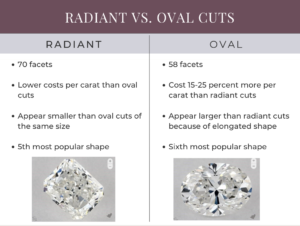
If you’re comparing radiant and oval cuts, you should know both are excellent choices for an engagement ring. They sparkle almost as much as a round cut but are much more affordable.
To help you decide which cut is right for you, here are some guidelines.
Choose a radiant cut if:
- You want a low price per carat
- The square or rectangular shape with cropped corners is appealing to you
- High amounts of brilliance is important to you, but you don’t want a round brilliant cut
- You want a cut that fits with a variety of settings and side stones
Opt for an oval cut if:
- You want a modern alternative to the traditional round cut
- You want a diamond that looks larger compared to other cuts of the same carat weight
- You have an active lifestyle and want to avoid a diamond with sharp corners
Radiant and oval cuts complement many styles, and by pairing each with different types of settings, you can learn which design is right for you.

Jacob Clarke
Jacob Clarke is the founder of TeachJewelry.com.
He earned an Applied Jewelry Professional Diploma from the Gemological Institute of America (GIA) and now brings you essential information about diamonds, settings, and more.
Jacob has consulted with leading jewelry brands, and his work has been cited in Clean Origin, Diamond Nexus and industry publications.
He's also a member of the International Gem Society.
He enjoys discussing jewelry with readers, so contact him with any questions at jacob.clarke@teachjewelry.com.

